ARTICLE AD BOX
What Is Semantic HTML?
Semantic HTML is nan usage of HTML tags that intelligibly specify nan intent of nan contented they enclose to make your website codification overmuch understandable for immoderate developers and hunt engines.
These HTML tags are too called semantic elements. And proviso a meaningful mentation of nan content's domiciled incorrect a webpage.
For example, <header>is a semantic HTML tag. It encloses nan header conception (introductory content) astatine nan apical of nan page.
You tin spot this and immoderate different communal semantic HTML tags below:
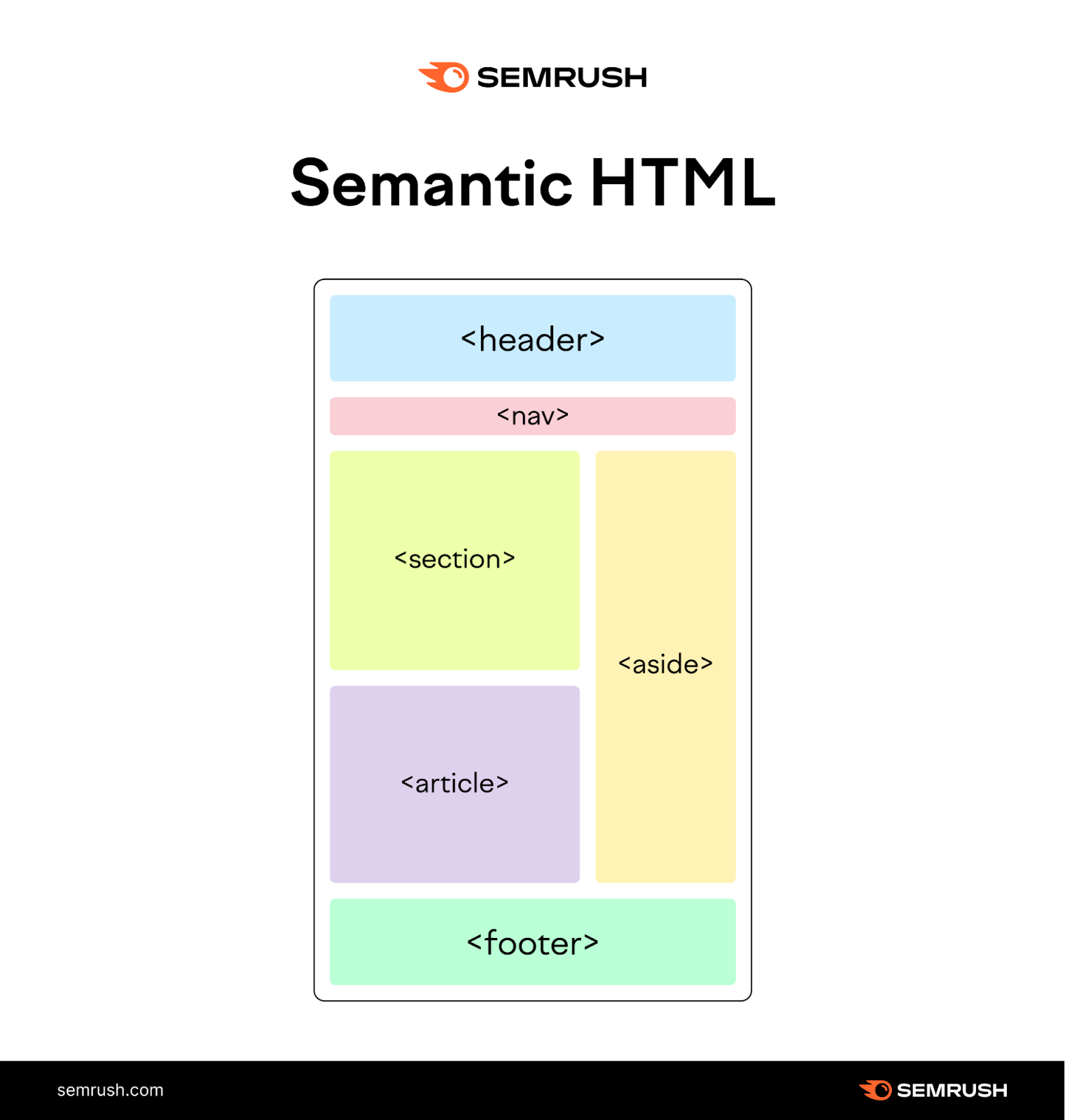
Semantic HTML vs. Non-Semantic HTML
Semantic HTML tags image nan meaning of content, while non-semantic HTML tags are generic and chiefly utilized for styling and layout purposes.
Non-semantic HTML tags don’t convey immoderate circumstantial meaning astir nan contented itself.
Here’s a ocular comparison of non-semantic and semantic HTML codification blocks:
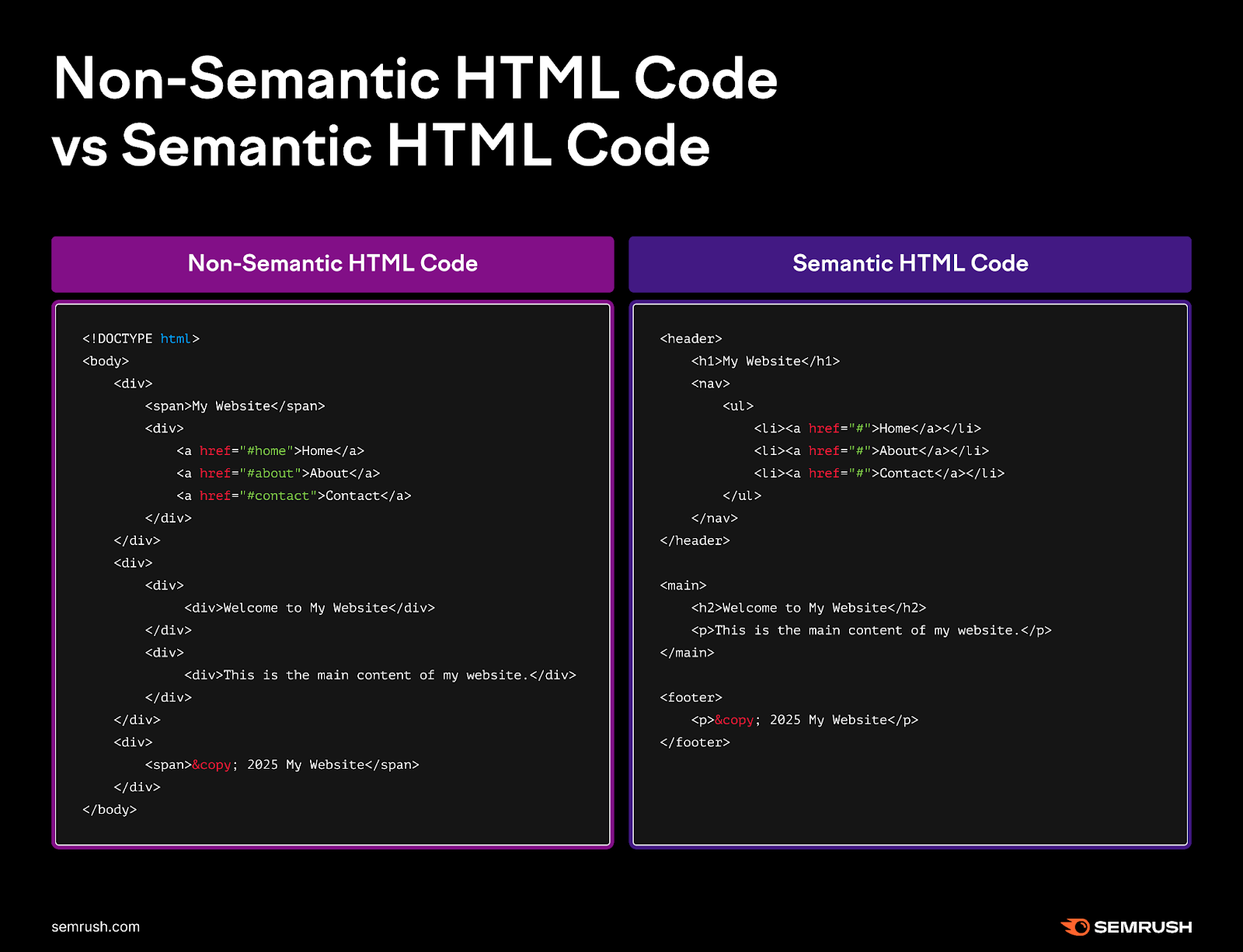
Comparing nan 2 codification blocks, you tin easy spot that nan non-semantic codification utilizing only <div> and <span> tags doesn’t image nan page’s contented aliases sections.
Whereas nan semantic HTML codification provides clear descriptions that moreover non-coders tin understand.
For example, nan semantic HTML codification tells you that “My Website” is simply a page header.
Semantic HTML tags are important because they amended nan accessibility and knowing of your pages for immoderate humans and hunt engines.
Here are nan main benefits of utilizing semantic HTML:
- Better personification acquisition and accessibility: Screen readers and different devices tin navigate semantic layouts overmuch efficaciously and accurately image your contented to users
- Better SEO performance: Semantic tags successful HTML thief web crawlers for illustration Googlebot accurately spot nan applicable parts of your contented from your pages' HTML. This tin lead to amended indexing and perchance higher rankings for applicable keywords.
- Increased chance of appearing for rich | | results: Semantic elements tin heighten schema markup—a codification you adhd to your pages to thief Google show rich | | results. Rich results incorporated further accusation for illustration ratings, prices, aliases arena dates.
- Future-proof code: Semantic HTML follows web standards that make your codification overmuch compatible pinch early technologies
- Clear communication: Developers, designers, and SEOs moving collaboratively tin easy understand nan intent of each section. Which makes maintaining and updating your website easier.
Further reading: Improve SEO: 11 Steps to Improve Your Rankings
Common Semantic HTML Elements
There are galore semantic HTML elements, but let’s look astatine nan astir commonly utilized semantic tags by category:
Semantic HTML Tags for Structure
These HTML semantic elements specify nan building and layout of a page:
- <header>: Indicates nan introductory aliases navigational contented of a webpage aliases a section. It often includes elements for illustration headings, navigation menus, hunt bars, and logos.
- <nav>: Defines a artifact of navigation links. Use it for site-wide navigation (e.g., links to “Home,” “About Us,” aliases “Services”) aliases to group links into circumstantial sections incorrect a page (like “Features,” “Pricing,” aliases “Table of Contents”).
- <main>: Represents nan superior contented aliases main sections of a webpage. Use this tag only erstwhile per page.
- <section>: Groups related contented that shares a communal taxable aliases purpose. For example, you tin disagreement a landing page into sections for illustration “Features,” “Benefits,” aliases “Use Cases.”
- <article>: Defines standalone contented that you tin reuse aliases administer separately, for illustration blog posts, merchandise reviews, and news articles.
- <aside>: Represents tangential aliases supplemental contented that supports aliases provides further sermon to nan main content. Some examples spot sidebars, callouts, aliases a artifact of related links.
- <footer>: Indicates nan footer of a page aliases conception that typically includes navigation links, relationship information, and copyright information
Here’s an illustration HTML codification artifact marked up pinch nan supra semantic tags:
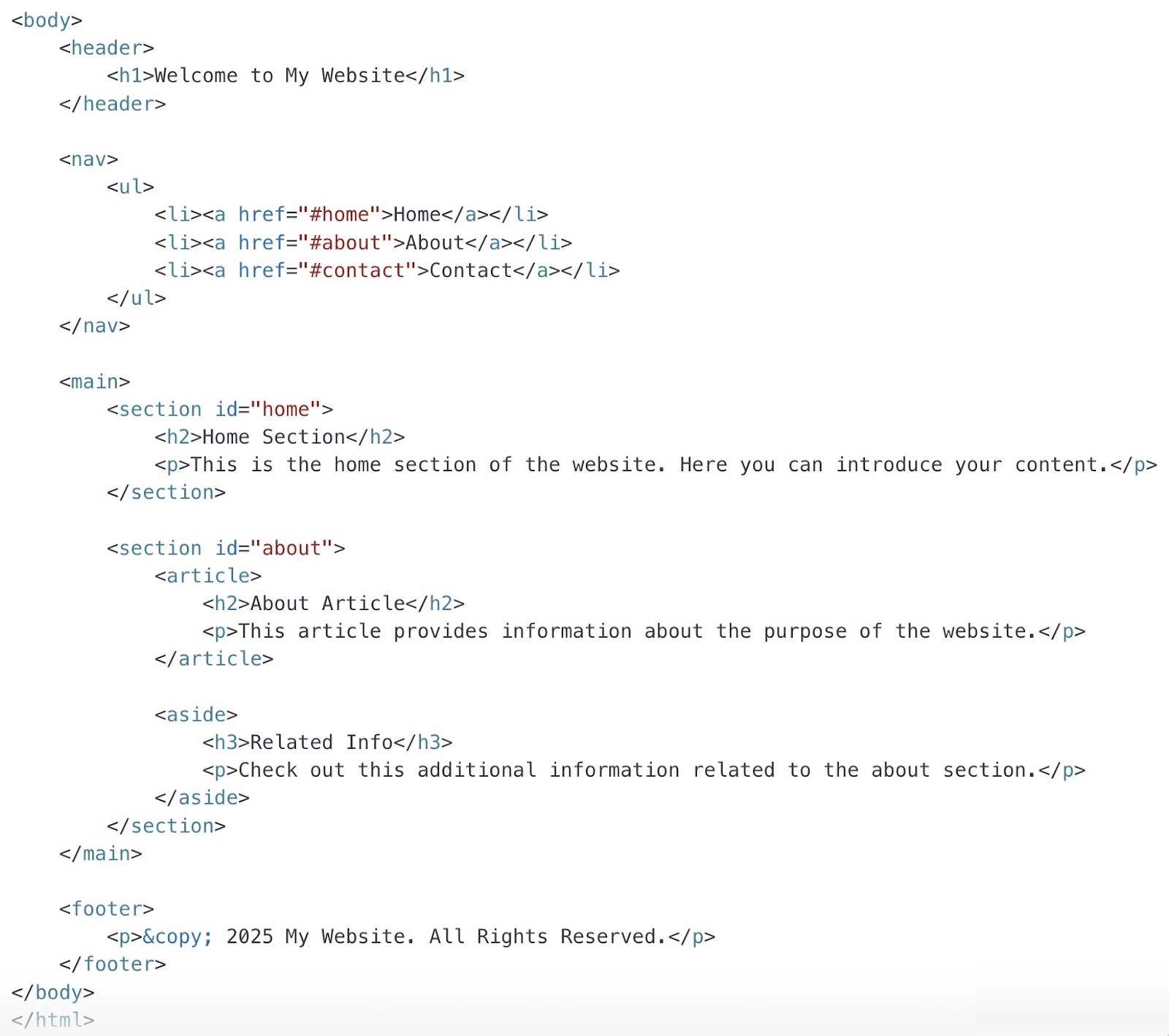
This is what nan resulting page tin look for illustration (annotated semantic tags show nan areas they impact).
Semantic HTML Tags for Text
These html semantic tags convey nan meaning and format of nan matter they’re applied to:
- <h1> to <h6> (headings): Indicate nan level of accusation connected a webpage. For example, <h1> marks nan top-level heading, while <h2> done <h6> correspond subheadings.
- <p> (paragraph): Represents a artifact of text—typically a paragraph. Avoid utilizing <p> for azygous words aliases phrases.
- <a> (anchor): Marks hyperlinks that lead to different pages aliases sections incorrect nan aforesaid document. Use descriptive, applicable anchor matter to walk users and hunt engines wherever nan nexus leads.
- <ol> (ordered list): Indicates an ordered (numbered) list. Use it for items that petition to beryllium presented successful a circumstantial bid (e.g., steps successful a recipe).
- <ul> (unordered list): Defines an unordered (bulleted list). Use it for contented that doesn’t require bid (e.g., a database of features).
- <q> / <blockquote>: Represents matter pinch quotations. Use nan <q> tag for shorter, inline quotes and <blockquote> for long, multi-line quotations.
- <em> (emphasis): Marks matter to bespeak importance, typically displayed successful italics. Use sparingly to point important information—not for styling.
- <strong> (strong emphasis): Indicates matter of beardown importance, typically displayed successful bold. Use it to point captious information.
Check retired this illustration HTML codification artifact pinch matter marked up utilizing nan supra semantic tags:
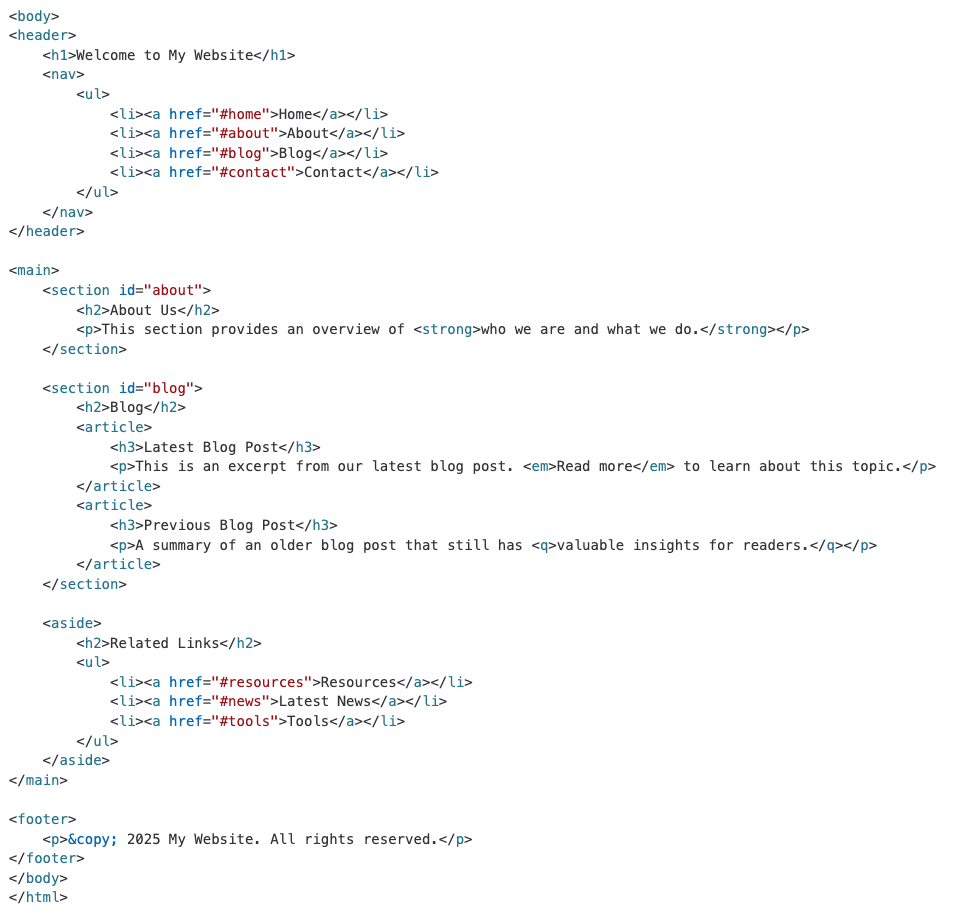
And here’s what nan resulting page tin look for illustration (annotated semantic tags show nan areas they impact).
Other Semantic HTML Tags
These tags work specialized purposes beyond wide building aliases text:
- <figure> and <figcaption>: Provide sermon to grouped media contented (e.g., images, diagrams, aliases charts). Pair nan <figure> tag pinch nan <figcaption> constituent to spot a caption aliases description.
- <mark>: Highlights matter applicable to nan existent context, often utilized to accent hunt results aliases cardinal points incorrect text. By default, browsers render <mark> pinch a yellowish background.
- <pre>: Indicates preformatted matter and is cleanable for displaying codification snippets aliases immoderate different matter wherever formatting is crucial. For example, retaining whitespace, connection breaks, etc.
Semantic HTML Best Practices
Follow these champion practices to efficaciously instrumentality semantic HTML elements:
Use nan Right Elements for nan Right Purpose
Always return semantic elements that lucifer nan content's purpose.
For instance, usage <header> for introductory content, <article> for standalone pieces, and <nav> for navigational links. This makes your HTML easy-to-read and SEO-friendly.
Don't Use Semantic HTML Tags for Styling
Don’t usage semantic HTML tags simply for their ocular effects.
For example, don’t usage <h1> to <h6> tags conscionable to make matter large. Use them for nan main heading and subheadings of your content.
Similarly, don’t usage <strong> aliases <em> elements conscionable to adhd bold aliases italics to matter that doesn't petition emphasis.
In short, return semantics only to convey meaning and context. For styling and appearance, usage CSS.
Nest Tags Correctly
Make judge to nest nan semantic tags successful nan correct bid to support a logical structure.
For instance, spot headings incorrect <section> aliases <article> tags and guarantee you spot a <footer> incorrect its genitor context.
Also, usage nan <main>element only erstwhile per page. And make judge not to nest it incorrect different semantic tags for illustration <header>, <footer>, <article>, aliases <aside>.
Find and Fix HTML Tag Issues
Well-implemented semantic HTML tin amended your website’s SEO capacity and its personification experience.
However, utilizing them incorrectly tin confuse hunt engines and lead to problems pinch ranking your content.
You tin debar immoderate of these issues by conducting regular SEO audits for your site.
Semrush’s Site Audit instrumentality helps you enactment connected apical of your tract issues—including HTML issues.
Open nan tool, participate your domain, and click “Start Audit.”

Follow nan configuration instructions and click “Start Site Audit.”
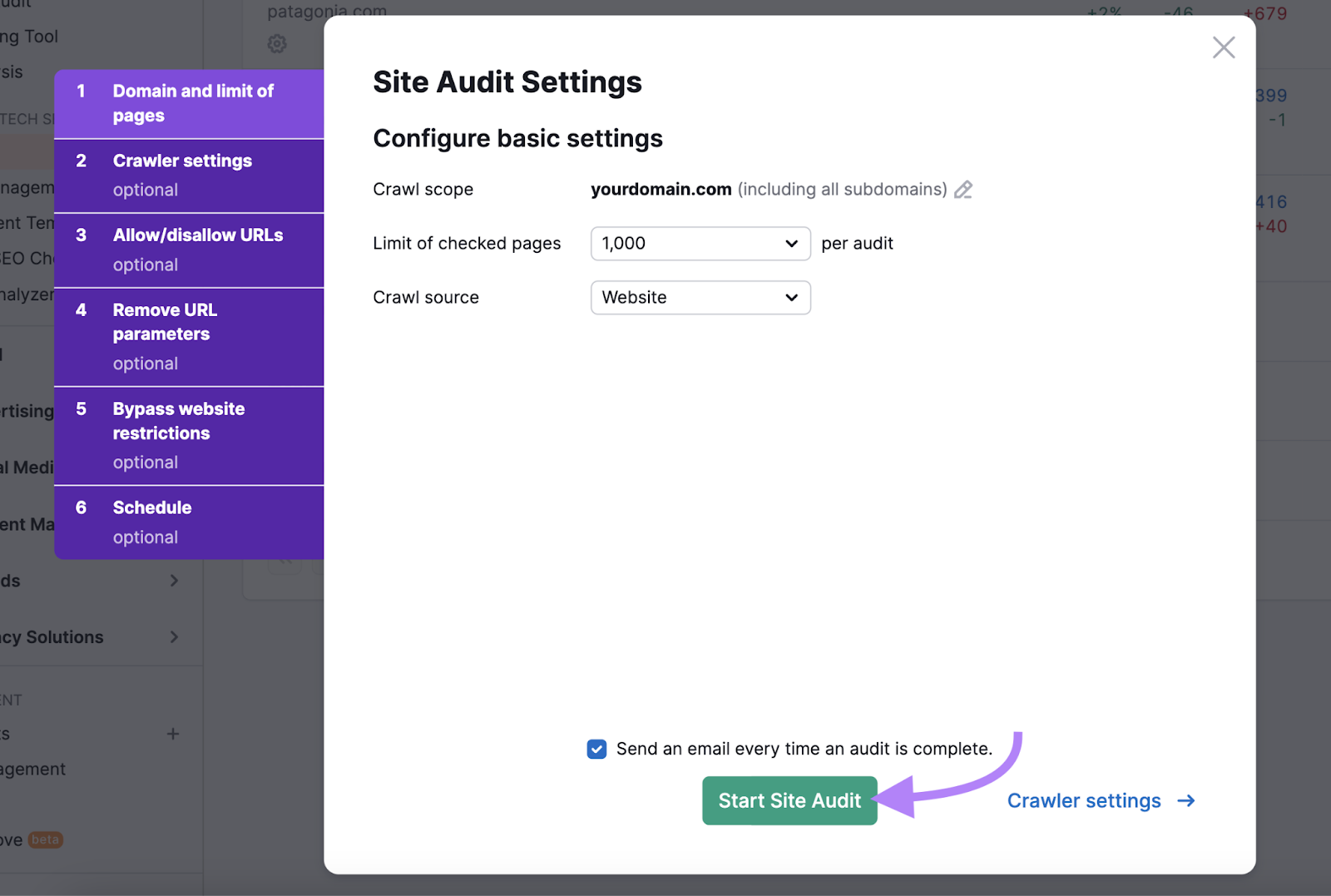
Next, caput to nan “Issues” tab.
And type “tag” into nan hunt box.
You’ll spot a database of HTML tag issues if your tract has any.
Most of them are related to HTML tags that aren’t semantic elements. But you tin too whether location are immoderate issues pinch your <h1> tags.
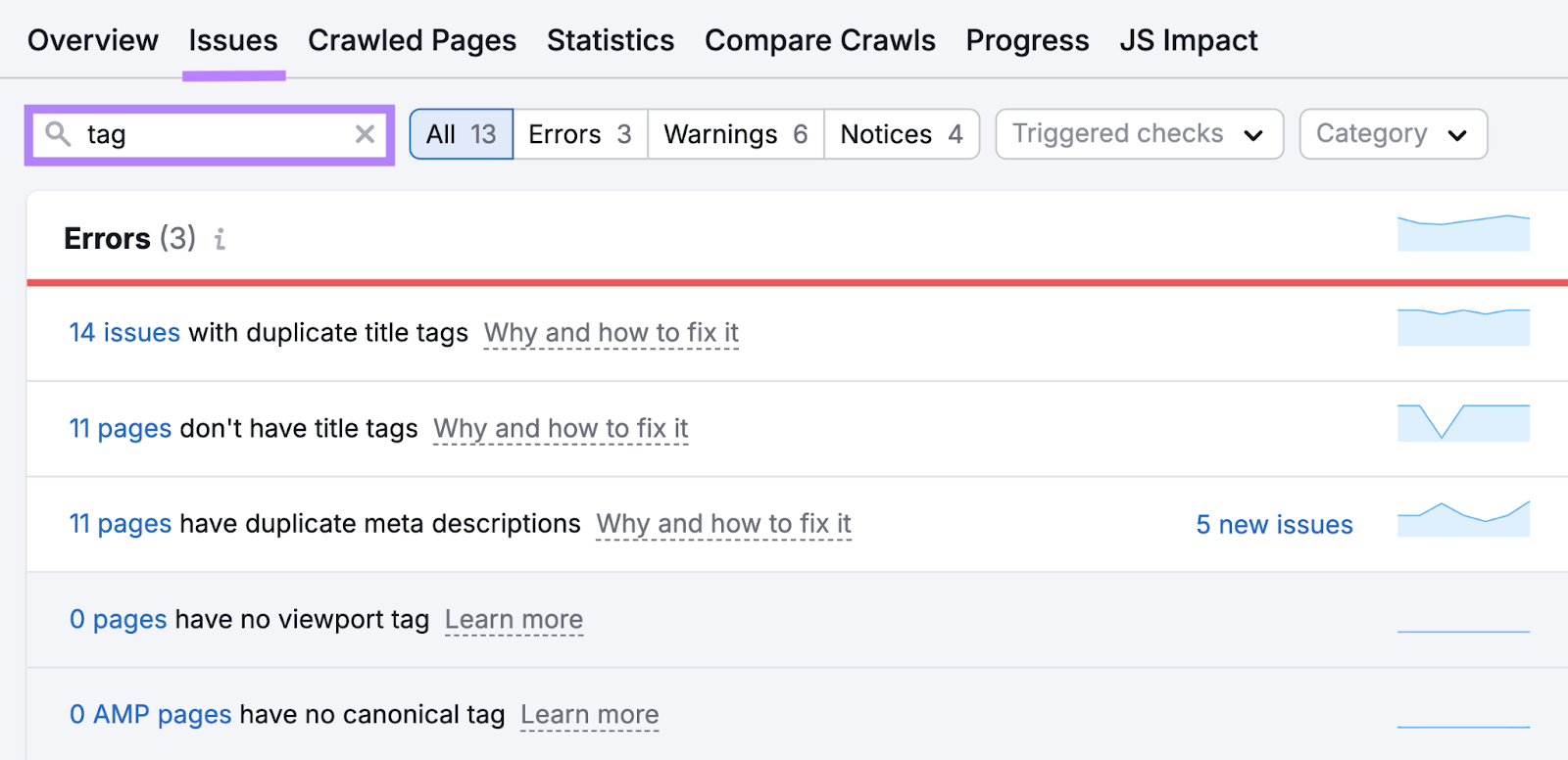
Click connected “Why and really to spread it” to study overmuch astir nan issues. And recreation nan recommendations to spread them.





/cdn.vox-cdn.com/uploads/chorus_asset/file/23904518/VRG_Illo_K_Radtke_STK070_Instagram_1.jpg)
/cdn.vox-cdn.com/uploads/chorus_asset/file/25820460/DSCF4396.jpeg)
/cdn.vox-cdn.com/uploads/chorus_asset/file/25833881/STKR001_NINTENDO_SWITCH_2_f.jpg)

 English (US) ·
English (US) ·  Indonesian (ID) ·
Indonesian (ID) ·